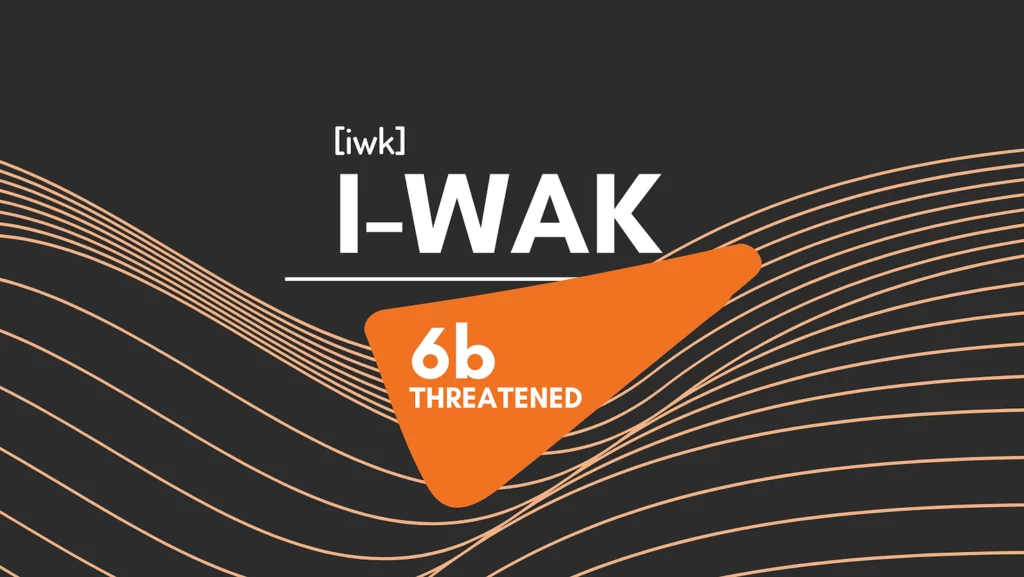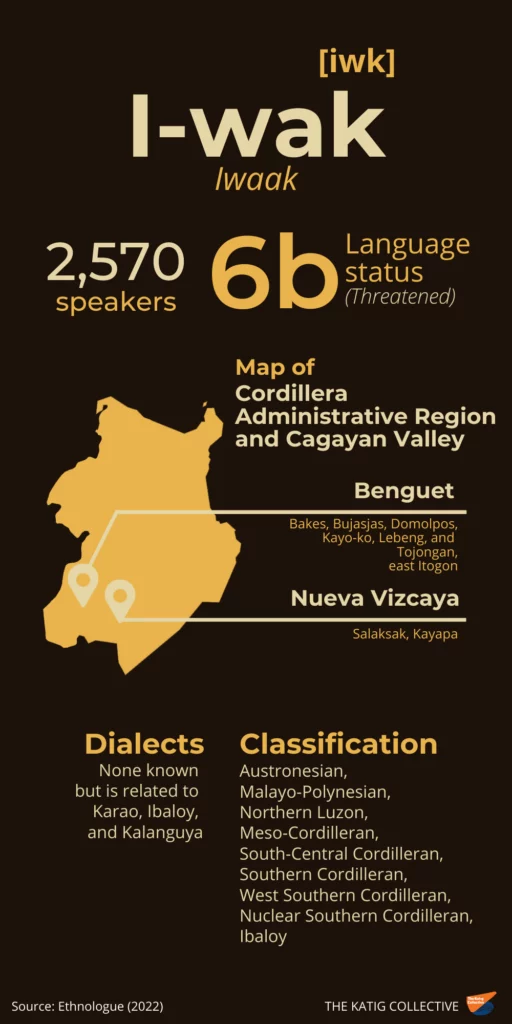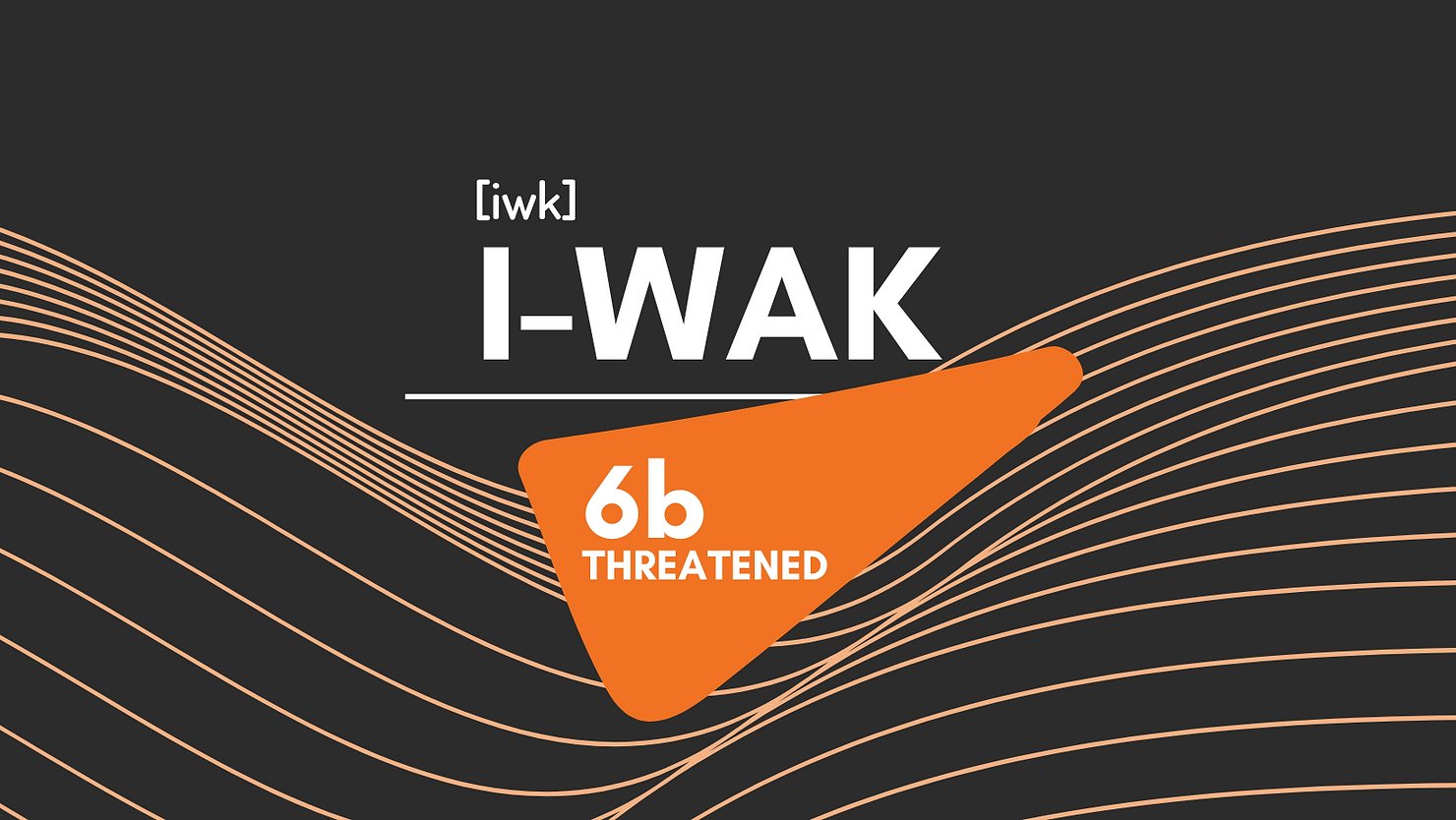I-wak
I-wak [iwk] is a threatened language (EGIDS 6b*) (Eberhard et al., 2022) used in several, dispersed communities in the Cordillera Administrative Region and Cagayan Valley, with high speaker densities in Kayapa and Boyasyas in Nueva Vizcaya (National Commission for Culture and the Arts, n.d.). According to a census of the United Nations Statistics Division, the I-wak language has a user population of 2,570 in 2005 (as cited in Eberhard et al., 2022).

Ways and worldviews
The I’waks are notable for their cultivation of taro and sweet potato, as well as their complex rituals (e.g. padit ‘prestige feast of an adult male’) that involve pigs (NCCA, n.d.). They also continue to observe animistic practices that ensure longevity and good health (e.g. sa’wak ‘diagnosis of the sick’) vis-à-vis environmental conservation, which allows the I’waks “to live in concordance with the ecological and social conditions of their domains” (Ramos & Cadoy, 2011, n.p.). Their worldviews and practices are best illustrated in the word li’teng which corresponds to the total well-being of an individual, denoting the harmony of the human mind and spirit with the surrounding cultural and environmental settings.
Works about I-wak
Several works and materials about the I-wak language and culture include Jesus Peralta’s “The I’wak” (1977) and I’wak Alternative Strategies for Subsistence: A Micro-Economic Study (1982), Bonifacio Ramos’ (2003) “The Abong: A Witness to the I’wak Simplicity, Tranquility and Accord with Nature,” and Fe Yolanda Del Rosario, Darwin Don Dacles, and Leonard Clemens Cadoy’s (2011-2012) “The I’waks, Coping in a Changing World.” Wordlists and other resources are also listed on the Open Language Archives Community.

References
Del Rosario, F. Y. G., Dacles, D. D. M., & Cadoy, L. C. L. (2011-2012). The I’waks, coping in a changing world: The continuities and discontinuities of their ethno-ecological adaptations. Journal of Northern Luzon, XXXIV(1-2), 32-60. https://tuklas.up.edu.ph/Record/IPP-00000130631
Eberhard, D. M., Simons, G. F., & Fennig, C. D. (2022). I-wak. Ethnologue: Languages of the world (25th ed.). https://www.ethnologue.com/language/iwk
I-Wak. (n.d.). California State University, East Bay. https://www.csueastbay.edu/museum/virtual-museum/the-philippines/peoples/i-wak.html
Joshua Project. (n.d.). Iwaak in Philippines. https://joshuaproject.net/people_groups/12295/RP
National Commission for Culture and the Arts. (n.d.). Peoples of the Philippines: Iwak. https://ncca.gov.ph/about-culture-and-arts/culture-profile/glimpses-peoples-of-the-philippines/iwak/
Open Language Archives Community. (n.d.). OLAC resources in and about the I-wak language. http://www.language-archives.org/language/iwk
Peralta, J. T. (1977). The I’wak. In A. R. Roces (Ed.), Filipino heritage: The making of a nation, volume 1. Lahing Pilipino Publishing, Inc. https://www.ortigasfoundationlibrary.com.ph/collections/library-holdings/filipino-heritage-making-nation-13
Peralta, J. T. (1982). I’wak alternative strategies for subsistence: A micro-economic study. National Museum. https://tuklas.up.edu.ph/Record/UP-99796217605720298
Ramos, B. V. (2003). The abong: A witness to the I’wak simplicity, tranquility and accord with nature. Journal of Northern Luzon, 31, 49-68. https://tuklas.up.edu.ph/Record/IPP-00000414741
Ramos, B. V., & Cadoy, L. C. (2011). The I’wak of Nueva Vizcaya: Their IKPs on Climate Change Adaptation, Good Health and Long Life, and Education. Documentation of Indigenous Knowledge and Practices on Health, Education, and Climate Change of Major Indigenous Peoples (IPs) of Northern Luzon. Academia.edu. https://www.academia.edu/31451169/THE_IWAK_OF_NUEVA_VIZCAYA_THEIR_IKPS_ON_CLIMATE_CHANGE_ADAPTATION_GOOD_HEALTH_AND_LONG_LIFE_AND_EDUCATION

